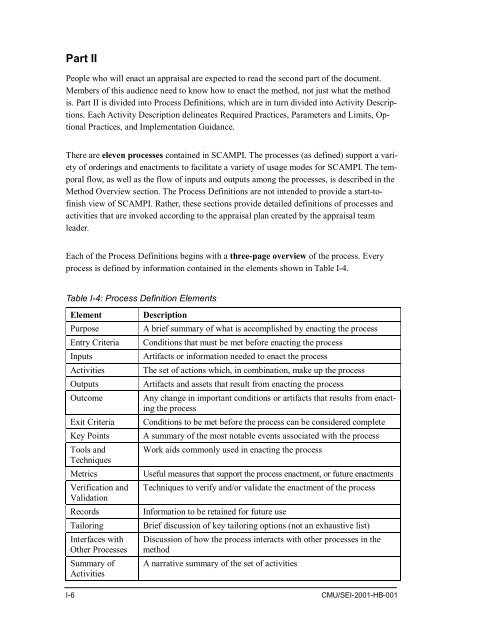Standard CMMI Appraisal Method for Process Improvement (SCAMPI)
Standard CMMI Appraisal Method for Process Improvement (SCAMPI)
Standard CMMI Appraisal Method for Process Improvement (SCAMPI)
You also want an ePaper? Increase the reach of your titles
YUMPU automatically turns print PDFs into web optimized ePapers that Google loves.
Part II<br />
People who will enact an appraisal are expected to read the second part of the document.<br />
Members of this audience need to know how to enact the method, not just what the method<br />
is. Part II is divided into <strong>Process</strong> Definitions, which are in turn divided into Activity Descriptions.<br />
Each Activity Description delineates Required Practices, Parameters and Limits, Optional<br />
Practices, and Implementation Guidance.<br />
There are eleven processes contained in <strong>SCAMPI</strong>. The processes (as defined) support a variety<br />
of orderings and enactments to facilitate a variety of usage modes <strong>for</strong> <strong>SCAMPI</strong>. The temporal<br />
flow, as well as the flow of inputs and outputs among the processes, is described in the<br />
<strong>Method</strong> Overview section. The <strong>Process</strong> Definitions are not intended to provide a start-tofinish<br />
view of <strong>SCAMPI</strong>. Rather, these sections provide detailed definitions of processes and<br />
activities that are invoked according to the appraisal plan created by the appraisal team<br />
leader.<br />
Each of the <strong>Process</strong> Definitions begins with a three-page overview of the process. Every<br />
process is defined by in<strong>for</strong>mation contained in the elements shown in Table I-4.<br />
Table I-4: <strong>Process</strong> Definition Elements<br />
Element<br />
Purpose<br />
Entry Criteria<br />
Inputs<br />
Activities<br />
Outputs<br />
Outcome<br />
Exit Criteria<br />
Key Points<br />
Tools and<br />
Techniques<br />
Metrics<br />
Verification and<br />
Validation<br />
Records<br />
Tailoring<br />
Interfaces with<br />
Other <strong>Process</strong>es<br />
Summary of<br />
Activities<br />
Description<br />
A brief summary of what is accomplished by enacting the process<br />
Conditions that must be met be<strong>for</strong>e enacting the process<br />
Artifacts or in<strong>for</strong>mation needed to enact the process<br />
The set of actions which, in combination, make up the process<br />
Artifacts and assets that result from enacting the process<br />
Any change in important conditions or artifacts that results from enacting<br />
the process<br />
Conditions to be met be<strong>for</strong>e the process can be considered complete<br />
A summary of the most notable events associated with the process<br />
Work aids commonly used in enacting the process<br />
Useful measures that support the process enactment, or future enactments<br />
Techniques to verify and/or validate the enactment of the process<br />
In<strong>for</strong>mation to be retained <strong>for</strong> future use<br />
Brief discussion of key tailoring options (not an exhaustive list)<br />
Discussion of how the process interacts with other processes in the<br />
method<br />
A narrative summary of the set of activities<br />
I-6 CMU/SEI-2001-HB-001
















